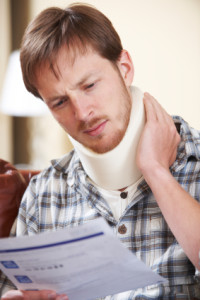 Road traffic collisions are one of the leading causes of death, costing the lives of 1.2 million people worldwide. The institution of seatbelts has decreased the level of mortality and morbidity associated with driving. Seatbelts prevent injury by reducing the chance of an occupant from hitting the inside of their vehicle or being ejected from the vehicle. However, as a result of seatbelt compliance, the rate of seatbelt injury is a new issue for drivers, health care workers, and legislators to deal with.
Road traffic collisions are one of the leading causes of death, costing the lives of 1.2 million people worldwide. The institution of seatbelts has decreased the level of mortality and morbidity associated with driving. Seatbelts prevent injury by reducing the chance of an occupant from hitting the inside of their vehicle or being ejected from the vehicle. However, as a result of seatbelt compliance, the rate of seatbelt injury is a new issue for drivers, health care workers, and legislators to deal with.
The aircraft type lap and chest seatbelt was first incorporated into car design in 1949. The American Medical Association (AMA) was convinced by the evidence of injury and death reduction that it was decided to make seatbelts mandatory in all motor vehicles. In 1954, the AMA voted in support of this action and seatbelts were installed in all automobiles afterward.
Seatbelt Injury from Pressure and Abrasion
Seatbelts reduce the injury severity of road traffic collisions by restraining car occupants to their seats. This helps the kinetic energy to be scattered away from the occupants when it is released from the rapid deceleration of a collision. The kinetic energy is disintegrated through the body’s skeleton. This also puts a tremendous amount of pressure on parts of the occupant’s body, often causing seatbelt injury.
Seatbelt injury usually consists of skeletal, soft tissue damage and visceral injuries associated with the two and three-point contact restraints of seatbelts. Seatbelts that only go across the hips cause more internal seatbelt injury because of the pressure put on the intestines and other organs in the lower torso. While the three-point restraint system that also goes across the chest is associated with more upper body injuries.
Common Types of Seatbelt Injury
Classic seatbelt injury consists of skin abrasions to the abdomen, neck and chest. Internal seatbelt injury is indicated in about 30 percent of cases. Abrasions of the neck are also associated with seatbelt injury to the carotid artery, cervical spine and larynx. Chest abrasions from seatbelt injury also accompany fractures of the ribs, sternum and clavicles. Seatbelt injury of the heart and thoracic aorta are also seen and abdominal abrasions accompany mesenteric tears, hematoma and bowel perforation.
Seatbelt Injury and Seatbelt Type
The types of seatbelt injury incurred are a result of the type of seatbelt being used. For instance, an unrestrained driver could incur abdominal injuries to the liver and spleen and also suffer lacerations and rupture while a person restrained by a two-point restraint would receive hollow viscus type abdominal injuries, such as mesenteric tears and perforations, and disruptions of the abdominal wall.
Likewise, there is a difference for chest and spine injuries as a result of seatbelt injury depending on the seatbelt type. Two-point restraint seatbelts produce more lumbar spine fractures, although these are considered “chance” injuries. A three-point restraint seatbelt would cause more chest and spine injuries, such as fractures of the clavicles and ribs. However, there is also the possibility of chance injuries like fractures of the lumbar spine and sternum from three-point restraint seatbelts.
Seatbelt Injury of the Extremities
Seatbelt injury of the extremities is not a common occurrence. Seatbelt injury of the extremities is more likely to occur from a side impact collision than it is from frontal impact, although side impact seatbelt injury can also consist of mid-body seatbelt injury. Seatbelt injury rarely affects the lower extremities.
Seatbelt Injury Lawyers
Seatbelts actually have little effect in preventing injury to the extremities. The most likely seatbelt injury problems that are likely to result from side impact collisions are nerve root avulsion. Nerve avulsion is when a nerve cell becomes detached from the point of insertion. This type of seatbelt injury commonly affects the brachial plexus, a network of nerve cells that control the shoulder, arm and hand. A brachial plexus seatbelt injury is usually the result of an impact causing excessive force of the seatbelt to the arm or shoulder region.
Paul & Perkins has been highly praised by Fort Myers car accident lawyer, Dennis Hernandez Tampa attorney as well as other prestigious attorneys across the state of Florida.
Sources:
Abbas, Alaa, Ashraf Hefny, and Fikri Abu-Zidan. “Seatbelts and road traffic collision injuries.” World Journal of Emergency Surgery. 6.18 (2011): 1749-7922. Web. 14 Sep. 2013. <http://www.wjes.org/content/6/1/18>.
Hayes, Curtis W., William F. Conway, James W. Walsh, Lynn Coppage, and Alfred S. Gervin. “Seat Belt Injuries: Radiologic Findings and Clinical Correlation.” RadioGraphics. 11.1 (1991): n. page. Web. 14 Sep. 2013. <http://radiographics.rsna.org/content/11/1/23.full.pdf>.
